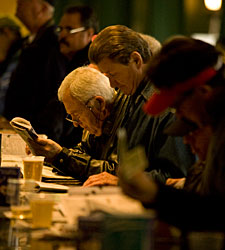Symposium: Customer Has to Figure in Equation

As U.S. racing faces the challenge of shaping race days and meets and maintaining field sizes at a time when foal crops are shrinking, experts said tracks and horsemen need to remember to keep the customer in the equation.
During a Dec. 10 discussion on shaping today's racing product at the Global Symposium on Racing & Gaming in Tucson, Ariz., panel members noted that the needs of the customer have to be considered.
"The schedule can't be defined only by what works for the tracks, owners, and trainers," said California Horse Racing Board executive director Rick Baedeker. "We also have to look at what's good for the customer."
Baedeker said sometimes those changes could work well for all involved, noting a reduction in racing might keep everyone fresh. But Baedeker, formerly president of Hollywood Park, said that in California there would be real concerns about moving from a four-day-a-week model to three racing days.
He believes racing could address some of its supply issues by bringing more horseplayers back to the game. He said race betting needs to be simplified for potential new players and the industry has to look at takeout issues. Takeout is the percentage of money from each wager largely retained to pay tracks and fund purses.
"If I'm running a poker game and I keep raising the percentage of money I'm keeping, at some point I'm going to have a player leave the game. That's fine if I have another player behind him waiting to take that seat," said Baedeker. But he noted that there doesn't seem to be new players lining up to bet on racing as U.S. handle is on pace to fall short of $10 billion for a fourth straight year in 2014.
Baedeker said he understands that sophisticated horseplayers want every bit of information available but he said that new players find this to be overwhelming and are intimidated by the game. Panelist Jim Cassidy, a Southern California-based trainer who heads the California Thoroughbred Trainers, said those feelings can be exacerbated by an intimidating self-service machine or unhelpful clerk.
In a late Tuesday session, Hong Kong Jockey Club head of broadcasting Oonagh Chan, said emphasis needs to be on giving the customer options. In a video presentation followed by a conversation via Skype, Chan said added cameras give fans the opportunity to choose their point of view and HKJC provides a second broadcast in which fans can actively participate in conversations. Improved high definition and technology will soon give fans the option to follow any horse in a given race.
"They feel like they are participating," Chan said. "Let them choose."
The New York Racing Association is moving toward more customer choice options on its NYRA.com site. Chan said the technology is bringing in younger players who are digitally oriented.
While bringing in new fans could eventually give the industry a solid foundation, racing faces current problems with its racing product.
With a number of tracks in the Mid-Atlantic region racing at the same time, it's difficult to maintain field sizes. Georganne Hale, racing secretary of Maryland Jockey Club, said she believes efforts begun by MJC owner The Stronach Group will result in some cooperation among the many tracks in the region.
"I think we're going to end up cooperating. The racetracks have to get together and the horsemen have to get together and we have to have a circuit," Hale said. "This running up against one another doesn't make any sense. There have been discussions on that. Everybody has to be on the same page. I think it will eventually happen, whether this year or next year."
Cassidy likes the idea of changing the way race purses are distributed, paying out to eighth place for instance, as a way of keeping more horses in training and horsemen participating.
"In my world, 20% of the trainers and owners make 80% of the money and 80% of the trainers and owners get 20% of the money," Cassidy said. "Changing the purse distribution could help some guys afford to stay in the game."
Baedeker encouraged industry groups to conduct more research on topics like the optimal number of races on a given race day. He said regulatory bodies are not set up to conduct such study.
"As the industry has struggled and declined, more people have looked to the regulatory body to say, 'save us, figure it out.' ... We really don't have a little think tank," Baedeker said. "We really don't have the ability to do that. We really rely on people who have a few bucks to go out and get the answers to those questions."
The conference is sponsored by the University of Arizona's Race Track Industry Program.
